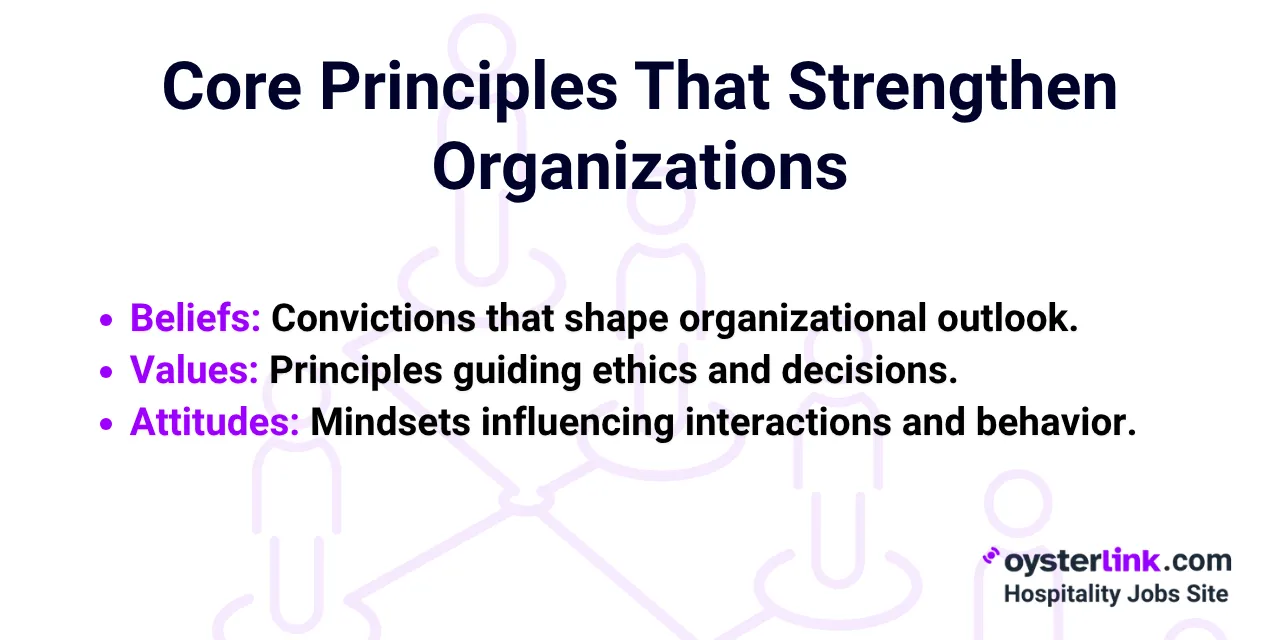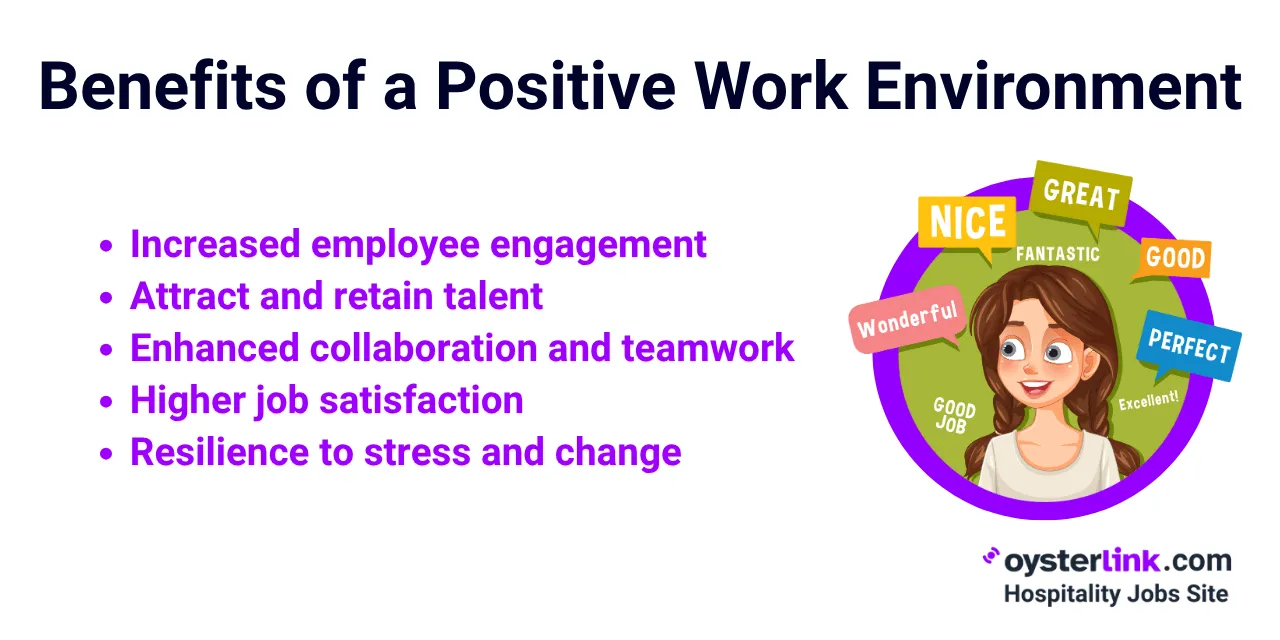Did you know that employees who have a positive experience at work are 68% less likely to consider quitting? This is why creating a positive work environment is essential for any organization aiming for success.
In this article, we will outline 20 effective ways (and examples) to build a positive work environment that employers can implement to foster a welcoming atmosphere for their teams.
How To Create a Positive Work Environment [With Examples]
Your work culture is shaped by the values, beliefs and attitudes that guide your organization, influencing how you interact with both your customers and employees.

Here's how you can create a positive work environment:
1. Establish core values
Defining and communicating core values is essential for fostering a positive work culture.
These values should align with the organization's mission and vision, guiding employees in their daily interactions and decision-making.
Example: If your company adopts "Integrity, Innovation and Inclusion" as its core values, each team meeting could discuss how these principles have been applied in recent projects.
2. Align values with actions
Once core values are defined, they must be consistently upheld across all levels of the organization. Leaders should exemplify these values, demonstrating their commitment through their actions.
Example: If transparency is a core value, executives should conduct quarterly town hall meetings to openly discuss the company's performance and strategic decisions.
3. Encourage open communication
Transparent communication is key to building trust within a team. Employees should feel safe to express their thoughts, ideas and concerns without fear of retaliation.

Example: Implement an "Open Door" policy where senior managers reserve specific hours per week dedicated solely to employee visits.
4. Foster a feedback culture
Regular feedback is vital for maintaining an open dialogue between management and staff.
Establishing regular check-ins and feedback sessions provides employees with opportunities to voice their opinions and contribute to the organization's development.
Example: Establish monthly feedback meetings where employees can discuss their experiences and suggest improvements.
5. Promote work-life balance
Organizations should encourage employees to establish clear boundaries between their professional and personal lives to prevent burnout, reduce stress and enhance overall job satisfaction.
Example: Policies such as flexible working hours, the option for remote work, or endorsing "no email" weekends help employees have sufficient time to recharge.
6. Consider flexible work arrangements
Offer flexible work options, such as remote work or adjustable hours, to help employees effectively manage their personal and professional responsibilities.
Example: Management can implement a policy that allows employees to start their day anytime between 7 a.m. and 10 a.m., accommodating various commitments like school drop-offs or morning workouts.
7. Encourage breaks and paid time off
Promoting regular breaks and paid time off keeps an employee’s mental health in check.
Example: Encourage staff to fully utilize their vacation days by implementing a "use it or lose it" policy that doesn’t allow hours to roll over to the following year. This ensures they take necessary breaks.
8. Recognize and reward achievements
Regularly recognizing employee contributions helps maintain motivation and satisfaction.
Example: Recognition can range from verbal praise during team meetings to more formal rewards, such as Employee of the Month programs where recipients receive a certificate and a bonus.
9. Celebrate milestones
Celebrating both team and individual milestones enhances a sense of community and belonging.
Examples: Consider establishing a "Milestone Wall" in a common area to acknowledge and celebrate achievements or organize a monthly team lunch where these milestones are recognized.
10. Foster team spirit
Encouraging teamwork and collaboration boosts creativity and problem-solving within the organization while reinforcing the work culture.
Examples: Implement regular brainstorming sessions where employees from various teams gather to discuss and solve challenges. You can also utilize collaborative tools for daily communication can keep ideas flowing and improve teamwork.
11. Organize team-building activities
Regular team-building exercises significantly strengthen relationships among employees.
Example: Consider organizing monthly activities — ranging from casual outings, such as bowling nights or team dinners, to more structured workshops focused on communication and trust-building, like escape rooms or outdoor survival skills challenges.
12. Encourage cross-department collaboration
Facilitating collaboration between different departments can spark innovative solutions and create a unified work environment.
Example: Establish cross-functional teams for specific projects, like a product launch or marketing campaign, to encourage diverse perspectives and skills.
13. Offer training and upskilling
Encouraging continuous learning through targeted training programs, workshops or access to online courses can greatly improve employees’ skills and knowledge.
Example: Incentivize the completion of courses with recognition or rewards to motivate your employees.
14. Embrace diversity and inclusion
A diverse and inclusive workplace is vital for fostering creativity and innovation.
Examples: Conduct regular training sessions on unconscious bias and cultural awareness to create an environment where all employees feel valued and respected.
15. Create employee resource groups
Initiate employee resource groups (ERGs) to provide support and networking opportunities for underrepresented groups and individuals.
Example: ERGs for women, LGBTQ+ employees or racial and ethnic minorities can offer tailored support and advocacy, host cultural awareness activities and serve as forums for discussing relevant issues.
16. Offer wellness programs
Implement wellness initiatives such as on-site fitness classes, access to mental health resources like counseling services or stress management workshops to help employees maintain a healthy work-life balance.
Example: Partner with local gyms to offer discounted memberships or provide subscriptions to mindfulness apps
17. Encourage mental health days
Promote mental health days to allow employees to take time off when they need it most, without stigma or penalty.
This practice demonstrates the organization's commitment to mental health and encourages employees to prioritize self-care.
Example: Implement a policy that allows for a specific number of mental health days per year separate from regular sick leave to show commitment to employee wellness.
18. Create a comfortable work environment
The physical workspace significantly impacts employee satisfaction and productivity. Strive to create a comfortable and inviting atmosphere.
Examples: Design office layouts to promote collaboration and comfort, incorporating open spaces with comfortable furniture and adequate lighting to enhance the overall work experience.
You can also encourage employees to personalize their workspaces with personal items or decorations to make the environment feel more welcoming and increase their sense of ownership.
19. Lead with empathy
Empathetic leadership fosters a positive work environment. Leaders should actively work to understand and meet the needs of their employees.
Example: Hold one-on-one meetings where you listen to employee concerns and provide supportive feedback.
20. Provide support during challenges
Offer support during challenging times, whether personal or professional, to build up employee loyalty.
Leaders should be approachable and proactive in assisting employees who are going through difficult situations.
Example: Creating support networks within the company for sharing resources and advice during crises, can effectively show support.
Key Benefits of a Positive Work Environment
Employees thrive in a positive work environment, so they can become more productive, engaged and innovative.
Here's a more detailed look at the key benefits:
- Increased employee engagement: When employees connect with the company culture, they are more likely to be engaged in their work.
- Attract and retain talent: A positive work environment attracts potential employees and retains existing ones, as people typically prefer working for organizations where they feel valued.
- Enhanced collaboration and teamwork: A positive work environment fosters an environment where employees feel safe to express their ideas and opinions without judgment. This openness improves teamwork and collaboration, as team members feel comfortable working together and sharing ideas.
- Higher job satisfaction: Employees are more likely to enjoy their jobs in a positive work environment. This satisfaction can lead to better mental health, reduced stress and a greater sense of fulfillment from their work.
- Resilience to stress and change: A positive culture equips employees with a support network that helps them cope with stress and adapt to changes. This resilience is essential during times of uncertainty or significant organizational transformations.

Role of Leadership in Building Workplace Positivity
Leaders play the most critical role in shaping a positive work environment. Their attitude, communication style, and consistency directly influence how employees feel and perform.
In his TEDx talk, Chris White from the University of Michigan’s Center for Positive Organizations shares how leaders can create high-performing, purpose-driven workplaces that bring out the best in their people.
Effective leaders lead by example — they practice transparency, recognize achievements, and make every team member feel heard. A supportive leader also encourages collaboration, handles conflict fairly, and promotes a culture of trust.
When leadership prioritizes empathy and respect, it sets the tone for the entire workplace, helping positivity grow naturally across all levels.
Examples of Companies With Positive Work Cultures
Some of the world’s most successful brands are proof that positive work environments drive lasting results. Companies like Google, Ritz-Carlton, and Patagonia have built strong reputations for prioritizing employee well-being, collaboration, and purpose.
In this short video, see how Google fosters innovation, inclusivity, and engagement through its unique workplace culture — inspiring employees to do their best work every day.
At Google, flexibility and innovation thrive through initiatives that encourage creativity and balance. Ritz-Carlton empowers employees to make decisions that elevate guest satisfaction, while Patagonia fosters loyalty by aligning company values with sustainability and social responsibility.
These examples show that investing in a positive culture not only strengthens internal engagement but also translates into better customer experiences and long-term business success.
How To Measure a Positive Work Environment in Your Organization
Measuring a positive work environment is key to ensuring your team is happy and healthy.
Before exploring specific strategies, this short video shares three simple ways to start measuring your company culture and identify where improvements can be made.
Here are additional methods to determine if your organization fosters a positive atmosphere:
- Employee surveys: Regularly distribute surveys that ask direct questions about aspects of the work environment, such as job satisfaction, relations with management and workplace culture. This can provide a quantitative measure of how positive the environment is perceived.
- Exit interviews: Conduct exit interviews to understand why employees are leaving. If departures are frequent because of cultural issues or dissatisfaction with the work environment, this might indicate areas for improvement.
- Performance reviews: Use performance reviews to evaluate individual employee achievements and gather feedback on the work environment. Encourage honest feedback by making these reviews a two-way conversation.
- Engagement metrics: Track engagement metrics such as employee turnover rates, absenteeism and participation in company events and initiatives. High turnover and absenteeism can be symptoms of a less positive work environment.
- Focus groups: Organize focus groups with employees from different levels and departments to discuss the work environment. These discussions can provide deeper insights into the daily experiences of employees and highlight areas of concern.
Creating a Positive Work Environment: Bottom Line
Creating a positive work environment is an ongoing process that requires commitment and effort from all levels of the organization.
By implementing these strategies, employers can reinforce a culture of respect, collaboration and growth, ultimately leading to a more engaged and productive workforce.
For restaurant owners aiming to boost employee satisfaction and decrease burnout, platforms like OysterLink can be an invaluable tool.
OysterLink offers valuable career advice for hospitality professionals, along with insights into industry trends and essential resources such as labor laws.










Loading comments...